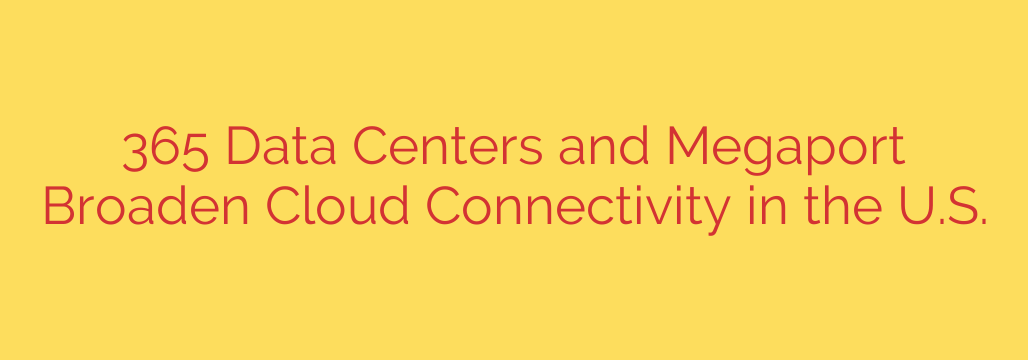
Supercharge Your Cloud Strategy: The Rise of Direct, On-Demand Connectivity
In today’s digital-first economy, a robust cloud strategy is no longer optional—it’s the backbone of business operations, innovation, and growth. However, as organizations increasingly rely on hybrid and multi-cloud environments, a critical bottleneck has emerged: the connection itself. Relying on the public internet to access mission-critical applications and data in the cloud can introduce unpredictable performance, security risks, and scaling challenges.
Fortunately, a new era of network connectivity is making these issues a thing of the past. Advanced solutions are now bridging the gap between on-premise infrastructure and major cloud providers, offering businesses a direct, private, and highly efficient digital highway to their most important resources.
What is Direct Cloud Connectivity?
Think of direct cloud connectivity as a private, dedicated fast lane to the cloud. Instead of sending your data over the congested and unpredictable public internet, you establish a secure, private connection from your data center or colocation facility directly to cloud service providers like Amazon Web Services (AWS), Microsoft Azure, and Google Cloud.
This is made possible through powerful Software-Defined Networking (SDN) and Network as a Service (NaaS) platforms. These technologies allow businesses to provision and manage their network connections through a simple software portal, bypassing the complex and time-consuming processes associated with traditional telecom services.
The Core Benefits of a Modernized Network Approach
Adopting a direct, on-demand connection model delivers transformative advantages that can immediately impact your bottom line and operational efficiency.
Enhanced Performance and Reliability: By avoiding the public internet, you eliminate issues like variable latency and packet loss. This results in a faster, more consistent, and highly reliable user experience for critical applications, whether for your employees or your customers. Data-intensive tasks like large file transfers, database backups, and real-time analytics perform significantly better.
Greatly Improved Security: Transmitting sensitive corporate data over the public internet exposes it to numerous threats. A private connection drastically reduces your attack surface, as your data never traverses the open web. This is a fundamental security upgrade that helps ensure data integrity and compliance with industry regulations.
Cost-Effectiveness and Scalability: Traditional network circuits can be expensive and rigid. Modern NaaS platforms offer a more flexible, consumption-based model. You can scale your bandwidth up or down in minutes to meet changing demands, ensuring you only pay for the capacity you actually need. This elastic approach eliminates over-provisioning and provides predictable costs.
Unmatched Agility for Hybrid and Multi-Cloud: The true power of this model is its flexibility. A business can spin up a secure, high-speed connection to a new cloud region or a different provider in minutes, not weeks or months. This agility is essential for building resilient and dynamic hybrid and multi-cloud architectures, allowing you to choose the best cloud service for each specific workload without being locked into a single ecosystem.
Actionable Security Tips for Your Cloud Connection
While direct connections are inherently more secure, optimizing your security posture is an ongoing process.
- Vet Your Providers: Ensure your data center and NaaS provider have a proven track record of security and reliability. Look for certifications like SOC 2 Type II and a clear commitment to physical and network security.
- Understand Shared Responsibility: Remember that security in the cloud is a shared responsibility. While the provider secures the connection infrastructure, you are still responsible for securing your data, applications, and access controls at each end of the connection.
- Implement Layered Security: Use your private connection as the foundation, but continue to employ other security best practices. This includes encrypting data both in transit and at rest, utilizing strong identity and access management (IAM) policies, and deploying firewalls and intrusion detection systems.
The Future is Direct and On-Demand
As businesses continue their digital transformation journey, the way they connect to their resources must evolve. The old methods of relying on the public internet or rigid, long-term carrier contracts are no longer sufficient for the demands of a dynamic, cloud-powered world.
The expansion of on-demand, software-defined connectivity into more data centers across the U.S. is a clear signal of this shift. For any organization looking to optimize performance, bolster security, and unlock the full potential of its cloud investment, establishing a direct and agile network strategy is no longer a luxury—it is a strategic necessity.
Source: https://datacenterpost.com/365-data-centers-and-megaport-expand-cloud-connectivity-across-the-u-s/








